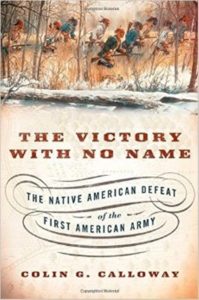Book Review: The Victory With No Name: The Native American Defeat of the First American Army
On November 4, 1791, a coalition of First Nations from the Great Lakes to the Ohio Valley destroyed the American army. This Indigenous victory represents the largest defeat of the United States military to date. Calloway in exploring The Victory with No Name seeks to not only explain the Indigenous victory and American defeat, but to unerase the disaster from American memory.
Unfortunately, Calloway spends more time examining American actions and motivations rather than those of the Indigenous Confederacy – American corruption, speculation, greed, and financial debt existing from Washington to the frontier, as well as the belief that America was destined to settle the Ohio. You learn, in a single chapter, that the Indigenous confederacy wanted to stop all American settlement in the Ohio and that the vast tribal alliance involving Miami, Kickapoo, Shawnee, Delaware, Ojibwa, Odawa, Potawatomi, and Mingos was an amazing diplomatic feat. What you do not learn are how leaders like Blue Jacket and Little Turtle were able to create and hold the confederacy together or why some nations refused to participate. Likewise, the concluding chapter and epilogue spend more time dealing with the fallout for the Americans albeit Calloway does briefly highlight the irony that more Indigenous people have served in the American military than against it.
Overall, Calloway’s book is a good first examination of the 1791 victory and can be commended for attempting to correct the historical period. Nevertheless, the work does place Settlers at its centre. A study that places the Confederacy and Indigenous voices at the centre is sorely needed.
Colin G. Calloway, The Victory With No Name: The Native American Defeat of the First American Army. New York: Oxford University Press, 2014.



